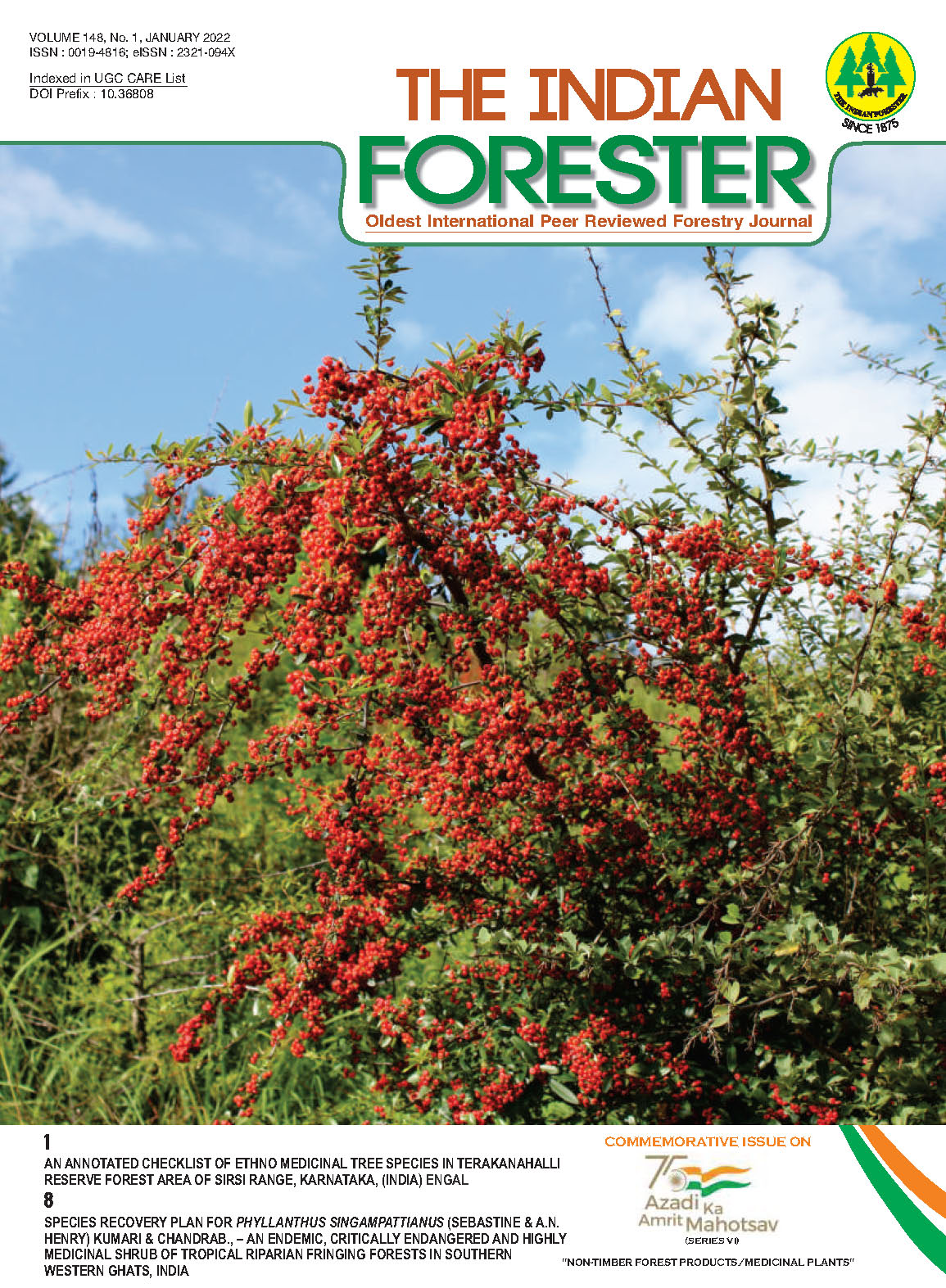Exploration, Distribution and Screening of Quality Germplasm of Medicinal Tree Oroxylum indicum (L.) Benth. Ex Kurz. (SHYONAK) in Forest Divisions of Haryana
DOI:
https://doi.org/10.36808/if/2022/v148i1/166492Keywords:
Oroxylum indicum, Germplasm, Endangered, Oroxylin-A, Baicalein and Chrysin.Abstract
Oroxylum indicum is an important medicinal plant, native to India and distributed throughout the country up to an altitude of 1200 m and found mainly in ravine and moist places in the forests. It is a high demand medicinal plant that has immense importance in many Ayurvedic formulations and preparations. The species, once found to be spread throughout the country, has now listed amongst endangered species in many parts of the country. Due to the indiscriminate collection, overexploitation and uprooting of whole plant bearing roots, gradual depletion of this valuable tree has been seen from its natural habitat. It is thus considered pertinent to conserve the germplasm of this commercially important medicinal species. The present study was, therefore, undertaken for mapping of the distribution, quantification and screening of the superior quality germplasms on the basis of principle active constituents of O. indicum in different forest divisions of Haryana. Four superior quality germplasms were screened out on the basis of active constituents having higher composition of Oroxylin-A, Baicalein and Chrysin, and these have been recommended for further multiplication, conservation and producing quality planting stock for Haryana Forest Department.References
Ali R.M., Houghtio P.J. and Hoult J.R.S. (1998). Antimicrobial and antiflammatory activities of extracts and constituent of Oroxylum indicum (L) Vent. Phytomedicine, 5: 375-381.
Anon. (2008). Ayurvedic pharmacopeia of India Volume 6: appendix 2.2.3-2.2.7; pp CCLXXVII- CCLXXVIII.
Darshan S. and Ved D.K. (2003). A balanced perspective for management of Indian Medicinal Plants. Ind. For. pp. 275-288.
Indian State Forest Report (2019). Forest Survey of India (Ministry of Environment Forest and Climate Change) Kaulagarh Road, P.O. - IPE, Dehradun
Jayaram K. and Prasad M.N.V. (2008). Genetic diversity in Oroxylum indicum 1-1 (L.) Vent. (Bignoniaceae), a vulnerable medicinal plant by random amplified polymorphic DNA marker. African Journal of Biotechnology. 5 February, 7(3): 254-262.
Mishra M. (2011). Conservation of biodiversity in the natural forests of central India: A case of critically endangered medicinal species safed musli in Bhopal forest (MP) India Bioscience Discovery, 2: 299-308.
Najar Z.A. and Agnihotri S. (2012). Need and Importance of Conservation of Endangered Tree Oroxylum indicum (Linn.) Vent. Asian Journal of Plant Science and Research, 2(3): 220-223.
Rao J.M., Katragadda S.B., Tatipaka H.B., Khanapur M., Purohit M.G., Pullela V.S. and Yadav J.S. (2007). Natural agent for treatment of gastrointestinal toxicity, associated symptoms and ulcers. United States Patent Appl. Publ. within the TVPP US20070651106. pp. 1-20.
Rastogi R.P. and Mehrotra B.N. (1998). Compendium of Indian Medicinal Plants, Central Drug Research Institute, Lucknow and Publications and Information Directorate, New Delhi. 5: 589.
Rojsanga P., Bunsupa S. and Sithisarn P. (2020). Flavones Contents in Extracts from Oroxylum indicum Seeds and Plant Tissue Cultures Molecules, 25(7), 1545.
Sankara S. and Nair A.G.R. (1972 a). Flavonoids from the leaves of Oroxylum indicum and Pajanelia longifolia. Phytochemistry, 11: 439-440.
Sankara S. and Nair A.G.R. (1972 b). Flavonoids of stem bark of Oroxylum indicum. Current Science, 41: 62-63.
Tamta B.P., Verma N., Kumar R. and Uniyal A., (2020). Distribution, Quantification and Selection of Superior Quality Germplasms of Oroxylum indicum (L.) Kurz (Shyonak) in different Forest Divisions of Uttar Pradesh. Indian Forester, 146(4): 338-346.
Yadav Akhilesh K., Manika N., Guru D., Bagchi Madan, M. Gupta (2013). Simultaneous determination of flavonoids in Oroxylum indicum by RP-HPLC. Med Chem. Res. DOI a10.1007/s00044-012-0214-8.
Zaveria M. and Jain S. (2010). Phytopharmacogostical Studies on Root Bark of Oroxylum Indicum, Vent. International Journal of Pharmaceutical Sciences Vol. 4(1): pp.132-135.
Downloads
Downloads
Additional Files
Published
How to Cite
Issue
Section
License
Unless otherwise stated, copyright or similar rights in all materials presented on the site, including graphical images, are owned by Indian Forester.





